What Is a Set Top Box? Here’s Everything You Should Know
Set-Top Boxe connects a TV to an external broadcast signal source. STB demodulate broadcast signals into audiovisual output that can be displayed or recorded.
Do you like watching TV shows or movies on your TV that you stream? Then your home entertainment system needs a set-top box.
It’s great to be able to watch your favorite TV shows and movies and other digital content whenever you want. Especially if you have a TV that can handle high definition.
A set top box is used for this. It converts video content to analogue or digital TV signals.
But what does it do besides that?
What Is a Set Top Box?
A set top box is a cable box that lets users watch videos from video providers over the internet. It is also called a set top unit. At first, they were used for satellite and cable TV.
But now, the main reason to use it is to stream movies and TV shows.
Set-top boxes can also change a digital television (DTV) signal into an analogue signal. Because of this, they are the best choice for people who want to use their analog TV to get digital broadcasts.
On top of that, they work by getting DTV broadcasts and decoding them so that they can be watched on a regular TV. They also let users choose between different providers and then narrow down to the videos they want to watch.
In other words, a set-top box sends a lot of channel choices to a TV’s secondary channel. Most set-top box systems today use two-way communication, which lets people use the interactive features.
This means that you can add premium channels right from the device and add internet access.
The difference between set top box, a cable box, and satellite receivers
A cable box is a piece of technology that turns digital TV signals into analog ones. A satellite receiver, on the other hand, receives and decodes radio signals that can be used to watch TV.
A set top box lets a TV receive and understand digital television (DTV) signals. As was already said, it’s a useful tool for people who want to use their analog TVs to get digital broadcasts.
Types of Set Top Box
Shortened to STB, a set top box is similar in size and shape to a video cassette recorder (VCR). It tunes into, receives and decodes HDTV signals.
HDTV signals can come from over-the-air broadcasts, digital satellites, or digital cables. But be careful when shopping for a STB as there are several types available on the market.
Listed below are the common kinds of STBs:
- HDTV tuners. This device tunes in, receives and decodes free over-the-air HDTV and DTV signals with an antenna.
- DirectTV receivers. It tunes in, receives, and decodes digital satellite signals with a satellite dish.
- All-in-one receivers. For this type of STB, it tunes in, receives and decodes both over-the-air and digital satellite HDTV and DTV signals. It requires both an antenna and a satellite dish.
- Cable HDTV receivers. It tunes, receives, and decodes digital cable signals.
Features To Look Out For
To ensure you are getting the best set top box unit for your home entertainment needs, here are the features you should look out for.
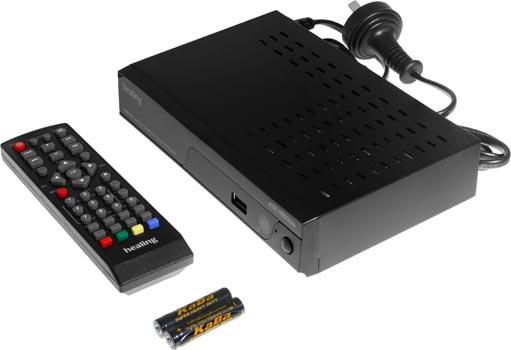
1. Storage
If you only want to stream movies with your set-top box, you might not need any storage. But if you have a lot of movies and music, you should choose a set-top box with storage built in.
This is important if you want to store the files and play them at the same time. You can keep all of the things you’ve collected on the device and watch them on your TV.
You will also be able to get rid of large movie files from your computer. When looking for one, try to find one that also has a couple of USB ports.
Just like this set-top box that lets you record from a USB (TV1052). It has a lot of features that let you watch HD movies while streaming.
We like this model because you can also record your favorite shows and pause and play back live TV. There is also a remote control.
2. Digital Living Network Alliance (DLNA)
DLNA allows you to access files from one device on another, including Apple devices. It replicates a lot of the best features of AirPlay.
Moreover, this feature enables you to grab files off your computer then send them to your TV—just like an iPad connecting to an Apple TV. You can get wireless capabilities like AirPlay with set top boxes and Blu-ray players.
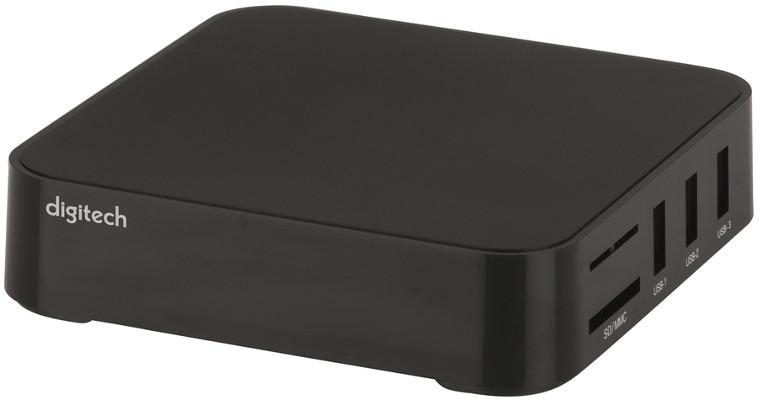
When you want to watch movies on your HD TV, nothing beats streaming the best content. Depending on the source, there are a number of set-top boxes that can stream 1080p and higher content.
For example, not all devices can stream Netflix in the best possible quality. If you care a lot about video quality, then you will like this 4K Android Media Player (JXC6012).
You can use this device to surf the web, watch movies, run apps and games, and more. You can use a Wi-Fi or wired network to connect to the Internet or watch media from a USB hard drive, flash drive, or SD memory card.
You can also watch your favorite media in either 1080P or 4K resolution with this advanced media player.
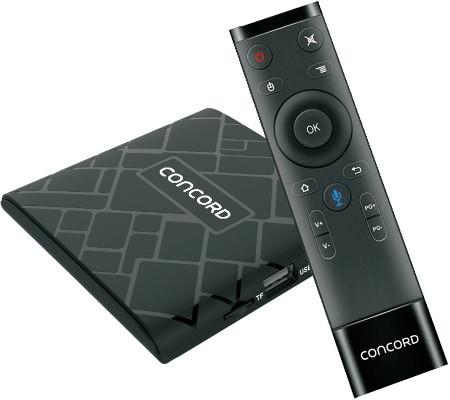
4. Remote control
When a set-top box comes with a remote, it makes things easier. This is why many people are looking for devices that can be controlled without having to walk up to the TV to change the channel.
With a remote, you can flip through your movie choices, pick one, and watch it from the comfort of your couch. There are even set-top boxes (smart media players) that can be controlled by voice as well as remotes.
This is a great feature that can also help you find your remote if you lost it in the couch cushions. Check out this Smart Media Player with Voice Assist from Concord (JXC6010).
This voice-activated smart media player has everything we’ve come to expect from a smart device. You will be able to use streaming services with high resolutions if they support 4K.
You can also use voice search to find things on YouTube and do more. When you connect this to your home network storage, it turns into a place where you can get music and videos all in one place.
It also has a LAN port and can connect to wifi. You can also enjoy what the net has to offer because the menus are easy to use.
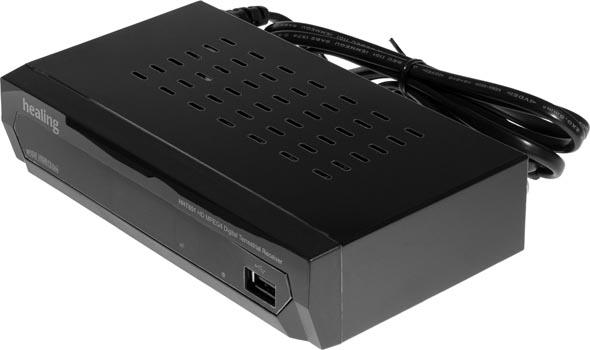
5. File support
No matter what type or brand of set-top box you want to buy, you should make sure it can play your files. For one thing, there are some units that can’t open AVI files.
Given how common AVI files are in movie and video formats, this could be a problem if yours do not support them. MP4 and MOV video files are usually universal, as are JPG, PNG, and MP3 music files.
But it might or might not work with other files, so make sure that the set-top box you want to buy can handle all the files you need. This HD DVB-T Set Top Box HDMI and Composite CVBS with Remote (TV2856) can play many different types of media files.
It is a good place to start if you want a huge library of media to stream on your streaming box. It can handle the following formats:
- AVI
- MP4
- MOV
- MP3
- OGG
- JPG
- BMP
- MPG
- MPEG
- VOB
- TS
- TRP
- M2T
- M2TS
- MKV
- DIVX
- TP
- DAT
- FLV
This set-top box makes almost any display a great place to watch TV. You can choose between HDMI and Composite outputs, which makes it easy to connect.
You can connect your USB storage device to record shows and pause and play back live TV. You can also use it to play movies, photos, music, and other media files.
It also comes with a remote, which is helpful.
Evolution of the Set Top Box
The STB industry has its roots in the legacy device called the “Table box.” With this device, a user can use a hand-held remote control to choose from a wide range of analog TV channels. Over time, as networks and service providers added more digital channels, satellite broadcast services, internet access, and other options, the STB was put on the market to support all of these new channels and services, which were mostly made possible by technological advances. As digital consumer services have become more popular in recent years, the STB is quickly becoming a device that can do more than one thing. With the arrival of digital TV and high definition TV, it is now possible to send and receive high-quality video. Digital broadcasts today use cable, terrestrial antennas, and satellite. Each type of transmission, reception, and fixing mistakes has its own set of rules. Before, the service provider could only send information to the STB in one direction, and the STB’s output was an analog TV. At the moment, it not only keeps working the way it did before, but it also provides a two-way communication channel with the service provider and sends a digital TV signal to modern TVs. An STB is supposed to be able to control home appliances, use the TV as a display screen, and send control commands from the Set-Top Box back to the service provider using a data modem. Today’s digital STBs have powerful microprocessors and complex hardware to make these advanced features work.
The STB Market
In the last ten years, the market for cable and satellite set-top boxes (STBs) has grown very quickly. This is because they now have more features, can play more media, and are easier to bill. Since 1998, it’s clear that satellite and cable boxes have become very popular, which has made more people want this technology. Statistics show that the number of units sold is going up, while the price per unit of each STB has gone down a lot, which is making more people want this technology. In 2006, people still want digital cable set-top boxes a lot. More and more cable TV companies around the world are ordering and installing cable Set-Top Boxes, especially in conjunction with digital cable video services and new high-definition and interactive TV services.
The market for digital cable Set-Top Boxes had a record year in 2005, which led to a rise in demand in 2006. Increased demand from cable TV operators in North America and new installations by cable TV operators in China helped bring the total number of units shipped around the world to 15.5 million in 2005, which was 44% more than in 2004.
The retail value of all Digital Terrestrial (DT) Set-Top Boxes around the world will “blast off” in 2006, and sales are expected to reach more than US$ 10 billion by 2009.
Satellite Set Top Boxes
Today, even the most basic satellite STBs have interactive features like video-on-demand (VOD), an electronic program guide (EPG), and digital rights management (DRM) (DRM). In addition to basic functionality, more advanced units go a step further and offer a suite of interactive and multimedia services directly through a user’s television system, such as Internet browsing, email, instant messaging (IM), and voice over IP (VoIP). Figure 1 shows a typical situation in which a satellite STB is connected.
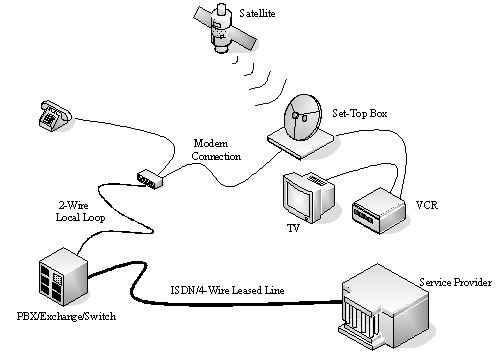
Embedded Modem for Billing and Interactive Gaming
Most satellite uplinks don’t have enough bandwidth for interactive features like VOD. So, an extra device is used to talk to the service provider and set up an alternative connection. Satellite Set-Top Boxes have dial-up modems built in that work with a regular two-wire phone line. These built-in modems can meet both low-speed and high-speed modem needs, and they can be used in any full line of satellite Set-Top Boxes.
Satellite Set-Top Boxes that only offer standard services usually have a low-speed modem to save money, since data transmission takes a short amount of time and only involves a small amount of data. High-speed modems are needed for services that are more advanced and need to send more data. Since modems have been around for a while and use the regular Public Switched Telephone Network (PSTN) lines, STB manufacturers and service providers can use high-speed modems in a cost-effective way.
Conclusion
Finding the right set-top box for your needs can be difficult. One thing is that there are a lot of things to think about before you buy something.
ad


Comments are closed.